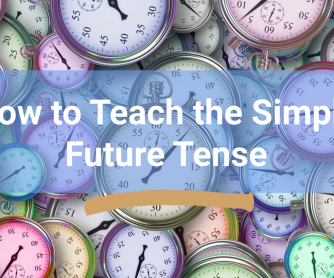Who knows what the future will bring? However, it does look promising, particularly for our ESL students, because once they master the major verb tenses, they’ll be better equipped to communicate in English. And while on the subject of the future…teaching the future simple tense ("will-future") is not as “simple” as it sounds. It actually involves teaching the future with “will” and the future with “going to”, plus teaching students to understand when they should use each.
Let’s go over the procedure of teaching the Simple Future Tense step by step:
How To Proceed
-
1
Introduce the Future Simple Tense with will
Ask a student, “Who is the President of the United States?”
S: Barack Obama is the President.
T: That's right. He will be President until the end of 2012.
Tell students we use will to talk about the future in general. Make sure they understand the conjugation is the same for all verbs. Go over other uses of “will” and give examples:
- For instant decisions: You’re hungry? I will make you a sandwich.
- For promises or voluntary actions: I will call you tomorrow.
Use this excellent worksheet to practice instant decisions with will. -
2
Introduce the Future SimpleTense with will – Negative form
Just as will is used to express voluntary actions, or things you are willing to do, its negative form won’t is used to express something you are not willing to do, or even refuse to do:
I'm tired of trying to talk to Sarah. I won't call her again.
Ask students to give you examples of things they refuse to do. -
3
Introduce the Simple Future Simple with will – Interrogative form
Model questions with will:
T: Will you help me with this?
S: Yes/Sure!
T: Will you go to tonight's concert?
S: Yes/No.
Ask students to ask each other questions with will that are either requests for help or assistance, or about the future in general. Model all types of questions first, with what, where, when, etc… -
4
Introduce the Future Simple with will – Short answers
Have students ask you questions about future events and reply with affirmative and negative short answers:
S: Will you give us homework for the weekend?
T: Yes, I will/No, I won't.
Ask students to ask each other yes or no questions with will, and have them practice replying in short answers. -
5
Introduce the Future Simple with going to
Unlike the future with will, where an instant decision is made, once you’ve made a decision, and it constitutes a plan, you use the future with going to to express it. Tell your students: I have special plans for the weekend. I’m going to visit my grandmother. Explain to students that the conjugation for the future with going to is the same as for the present continuous. Provide plenty of examples in different persons: You are going to have a special class next week. A student from London is going to speak to the class. We are going to listen to his experience studying in the UK.
Ask students to give examples of things they are going to do next weekend, but make sure they understand they must be things they have already planned to do. -
6
Introduce the Future Simple with going to – Negative form
The future with going to in negative form, likewise, is used to express things we have decided not to do. Give examples by alternating between negative and affirmative forms: I am not going to give you homework for tonight. I’m going to give you some exercises for the weekend.
Ask students to do the same: Bon Jovi is not going to come to town next month. They are going to be here in December. -
7
Introduce the Future Simple with going to – Interrogative form
Model questions with going to: Are you going to buy tickets for the concert tonight? Is President Obama going to cancel his trip? Are you going to study for the test?
Have students ask questions in different persons. -
8
Introduce the Future Simple with going to – Short answers
Have students ask you questions about future events with going to and reply with affirmative and negative short answers:
S: Are you going to give us a difficult final test?
T: Yes, I am/No, I'm not.
Ask students to ask each other yes or no questions with going to, and have them practice replying in short answers. -
9
Contrast both forms of Future Simple
Make sure students understand that either form can be used for the future in general, but in some cases only one is correct. When making a decision at the moment of speaking, we use will: Where is John? He’s late. I’ll give him a call. But once the decision has been made, we use going to:
S: Where are you going?
T: I’m going to call John to see why he’s taking so long.
This worksheet provides some wonderful exercises for both types and clearly illustrates the contrast.
At BusyTeacher.org, you have dozens of Future Simple worksheets at your disposal. Download as many as you’d like, or make your own, with games, songs or videos. But looking to the future is something both you and your students should enjoy.
P.S. If you enjoyed this article, please help spread it by clicking one of those sharing buttons below. And if you are interested in more, you should follow our Facebook page where we share more about creative, non-boring ways to teach English.








